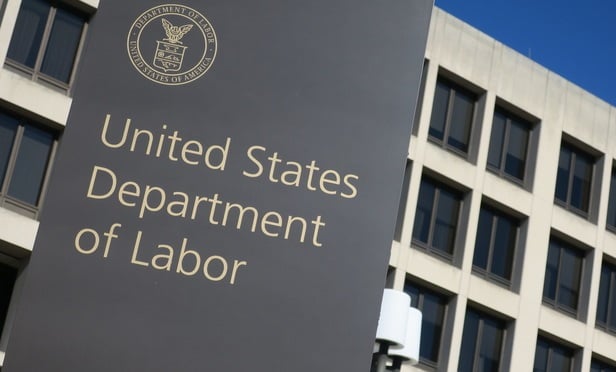 Labor's final rule notes the SECURE Act's progress, and its language on Open MEPs, which regulators say is significantly different from their final rule. (Photo: Mike Scarcella/ALM)
Labor's final rule notes the SECURE Act's progress, and its language on Open MEPs, which regulators say is significantly different from their final rule. (Photo: Mike Scarcella/ALM)
The Labor Department has released a final rule on Multiple Employer Plans that it says “could” offer small businesses more affordable and less burdensome retirement plans, and level the playing field for employees of small businesses by getting them access to lower cost savings plans.
The final rule tracks closely with last year's proposed rule in that it stops short of creating Open MEPs, which allow non-affiliated businesses to band together to create one retirement savings plan.
The final rule also prohibits mutual fund companies, banks, 401(k) recordkeepers, and insurance companies from sponsoring MEPs, which is consistent with last year's proposed rule.
MEP sponsorship is limited to Professional Employer Organizations (PEOs) and established employer groups, such as Chambers of Commerce.
“The final rule is super consistent with the initial proposal,” said Kevin Walsh, a principal with the Groom Law Group.
The rule's proposed release drew wide-ranging criticism across the financial services industry and from some ERISA attorneys for its narrowness, and its failure to leverage existing service providers to sponsor Open MEPs.
Despite the final rule's narrowness, the Labor Department left Open MEPs as an “emerging issue,” said Walsh.
The Labor Department “is not opining on whether other types of MEPs with different or less-stringent criteria, or different 'employers,' may also qualify under title I (of ERISA),” according to language in the final rule.
Labor also released a separate 16-page request for information on Open MEPs. Comments on the RFI are due at the end of October of 2019, and “may form the basis of future rulemaking under ERISA,” according to the RFI.
Nearly half the stakeholder comments Labor received were supportive of expanding the rulemaking to include Open MEPs that could be sponsored by existing retirement plan service providers, according to regulators.
Other commenters were leery of expanding Open MEP sponsorship to service providers.
“After reviewing the comments, the Department is persuaded that Open MEPs deserve further consideration,” the final rule says. “The Department, however, does not believe that is has acquired a sufficient public record on, or a sufficiently thorough understanding of, the complete range of issues presented by the topic.”
Individual employers in MEPs still responsible for selecting, monitoring providers
Under the rule, sponsors of MEPs, such as PEOs or other qualifying organizations, will be the plan administrator, responsible for overseeing compliance with ERISA, including reporting, disclosure, and fiduciary obligations.
The PEOs or qualifying associations will be “subject to all of the ERISA provisions applicable to defined contribution retirement plans, including the fiduciary responsibility and prohibited transaction provisions in title I of ERISA,” the rule says.
“The employer group or association or PEO would act as a plan administrator and named fiduciary and, thus, would assume most fiduciary responsibilities,” according to the rule.
Individual employers in a MEP will maintain a fiduciary obligation in selecting and monitoring providers.
Substantial business purpose vs. a solely commercial operation
In defining which entities could sponsor a MEP and satisfy ERISA's definition of “employer,” regulators said the sponsoring group has to have a substantial business purpose unrelated to offering employee benefits.
In doing so, Labor separated the bona fide associations of employers that Congress intended to cover under ERISA from “solely commercial operations,” the rule says.
“The Department is confident that the final rule will prompt some small businesses that do not currently offer workplace retirement benefits to offer such benefits,” the rule says. “This will increase the number of employees enrolled in workplace retirement plans, thereby offering some of America's workers better retirement savings opportunities and greater retirement security.”
An entity that exists solely to offer retirement benefits “would never qualify” under the final rule's safe harbor for sponsors of MEPs. “The importance of this safeguard should not be underestimated,” said regulators.
Pending SECURE Act
The Labor Department “punted” on the question of Open MEPs in light of pending retirement legislation that Congress is considering. That legislation would leverage Congress's statutory powers to amend the Employee Retirement Income Security Act to allow Open MEP sponsorship by industry service providers, said Walsh.
“Sometimes regulators don't want to act if relevant legislation is imminent,” he said, referencing the Setting Every Community Up for Retirement and Enhancement Act, or the SECURE Act of 2019.
The SECURE Act passed out of the House of Representatives in May by a nearly unanimous vote. But its progress in the Senate has been slowed, as key lawmakers have placed a hold on the bill over non-retirement plan provisions.
Labor's final rule notes the SECURE Act's progress, and its language on Open MEPs, which regulators say is significantly different from their final rule.
“This rule is significantly more limited in scope because it relies solely on the Department's authority to promulgate regulations administering Title I of ERISA,” the rule says. “Unlike the Department, Congress has authority to make statutory changes to ERISA and other areas of law that govern retirement savings.”
“The final multiple employer plan rule released by the Department of Labor today is limited in scope, recognizing that only Congress may change the underlying statutes,” said Ed Murphy, president and CEO of Empower Retirement, in a statement to BenefitsPRO. “Empower supports any effort to increase access to the workplace retirement savings system.”
Empower and Murphy were among the chorus of industry stakeholders that was critical of the proposed rule's narrow approach on attempting to expand access to retirement plans through MEPs.
“We continue to urge the Senate to pass the SECURE Act which provides a much broader expansion of multiple employer plans,” said Murphy.
As it now stands, passage of the SECURE Act will only happen this year if lawmakers are willing to attach it to one of 12 must-pass spending bills required to fund the government for the next fiscal year.
“There is still a path forward for the SECURE Act, but optimism is slowing down,” said Walsh.
Final rule signals EBSA will move forward with its regulatory agenda
The recent resignation of former Labor Secretary Alexander Acosta, and appointment of Patrick Pizzella to interim Secretary of the Department, has raised questions as to whether the Employee Benefits Security Administration—the arm of Labor that oversees retirement policy—will stick to its regulatory agenda.
Among other items, EBSA is expected to issue a new fiduciary rule this fall, and new guidance on electronic disclosures for retirement plans.
The Trump administration has appointed Eugene Scalia the new Labor Secretary, but the timetable for his confirmation process is unclear.
Despite the turnover, the release of the final rule on MEPs signals that EBSA, under the leadership of Assistant Secretary of Labor Preston Rutledge, will move ahead with its agenda, said Walsh.
“They got this rule through with an acting Labor Secretary—that's a big thing,” he said. “It signals Labor is going to continue with its regulatory agenda.”
© 2025 ALM Global, LLC, All Rights Reserved. Request academic re-use from www.copyright.com. All other uses, submit a request to [email protected]. For more information visit Asset & Logo Licensing.








